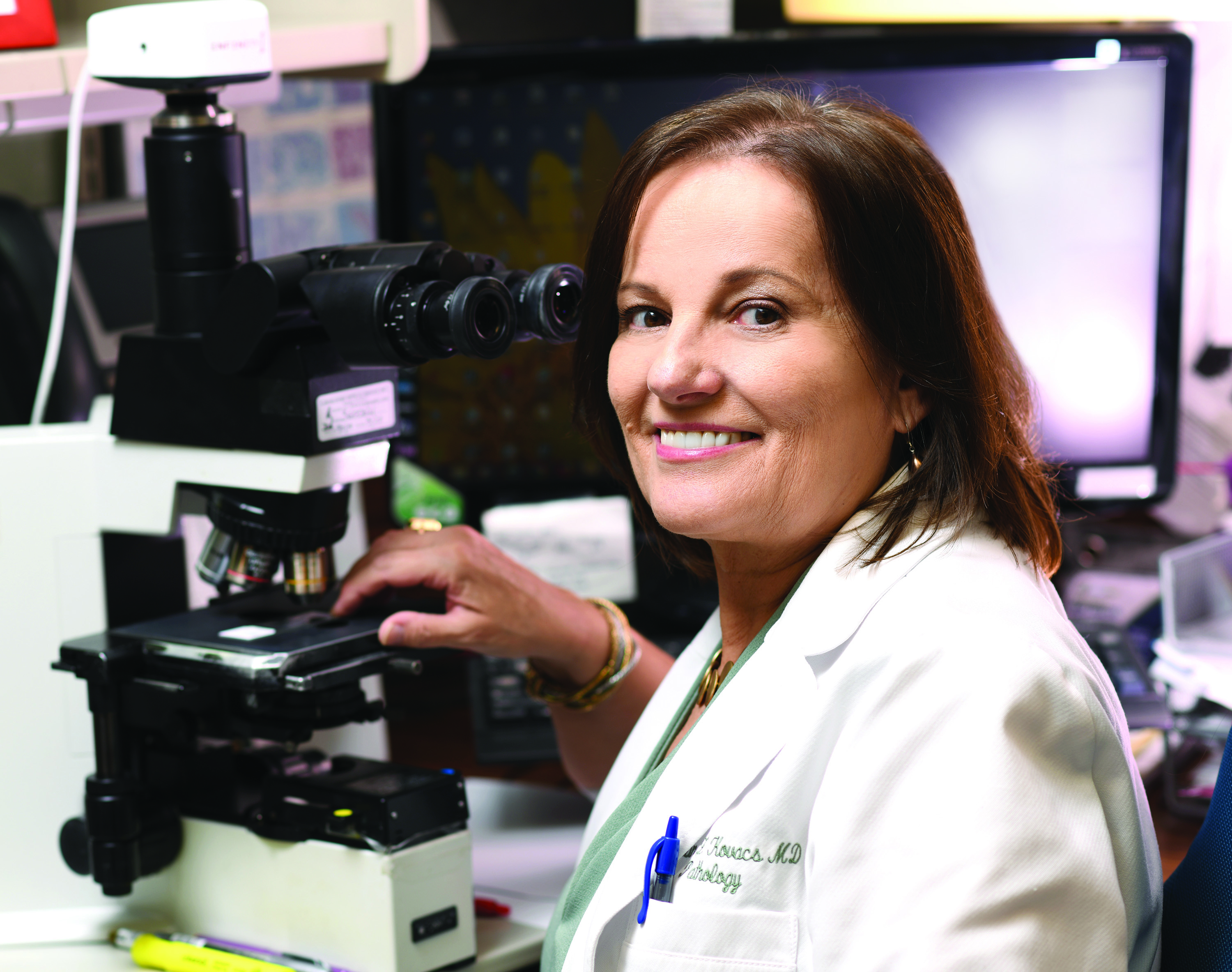Pathology
Moving from suspicion to certainty

The interval between a suspicious finding – a lump in the breast, an abnormal mammogram – and a definitive diagnosis can seem both unbearably long and incredibly short.
“Sometimes women feel something. Sometimes, their doctor feels something during a clinical exam. And sometimes, they come in for a screening mammogram and the radiologist sees something that’s not part of the regular architecture of the breast,” said King’s Daughters pathologist Katalin Kovacs, M.D.
Making a definitive diagnosis requires looking at the suspect tissue face to face. Radiologists collect the sample during a procedure called a needle biopsy, which may be guided by ultrasound or 3D mammography. “They collect a very small specimen, often only a few millimeters in length,” Dr. Kovacs noted.
During an overnight process, the water and fluids from the sample are slowly replaced with liquid paraffin, which maintains the natural shape and form of the sample. The next morning, the sample is embedded in a block of additional paraffin and sliced into 3.5 micron sections by the histotechnologist. (For reference, 3.5 microns is less than the width of a human hair.) After the slices are mounted to a glass slide and stained, they are ready for examination by the pathologist.
“We talk about breast cancer as though it is all the same,” Dr. Kovacs said, “But it’s not.” There are 26 different types of breast cancer, she said, and the pathologist has to know what each one looks like during its various stages of development. It is the pathologist who makes the determination of benign or malignant and provides the essential information that allows the medical oncologist, breast surgeon and radiation oncologist to select the best treatment for the individual patient.
Often, these treatment decisions include surgery, chemotherapy and radiation therapy. The sequence in which these occur depend in large part on what the pathologist finds in the initial biopsy.
The pathologist’s role in breast cancer treatment doesn’t end with the diagnosis. They receive the entire tumor as soon as it is removed and perform a thorough evaluation, which includes the weight, size, color and shape of the tumor as well as visible abnormalities. Sometimes during surgery the pathologist examines frozen tissues, Dr. Kovacs said. The pathologist also determines whether lymph nodes have been affected by the cancer, helping guide the surgeon’s hand.
After surgery, the pathologist’s job continues, with further classification of the tumor and determination of whether there is vascular or perineural invasion, which can indicate how aggressive the cancer is, what is the appropriate treatment, and what is the prognosis.
It’s the pathologist who reviews biopsies and tissues to determine whether, and how well, treatment has worked. For example, Dr. Kovacs recalled a recent instance in which she reviewed 95 slides from a surgical case, more than the average 20 to 25 slides per case. The patient had a large tumor and was given chemotherapy to reduce its size before surgery. “When we looked at the tissue, we could not find evidence of any remaining tumor in her breast. It’s rare, but it happens.”
All told, Dr. Kovacs and her colleagues – Shamsa Haroon, M.D., Malisha Johnson, D.O., and Diane Pierson, D.O. – evaluate 350-plus potential cases of breast cancer each year. But that’s not all. The team examines every specimen that comes to the laboratory, not just breast tissue, about 250 to 350 slides per day.
“Pathologists are medical doctors who, in addition to completing medical school, undergo another five to six years of training. Pathologists have to know all of the organ systems, all of the diseases, and all of the abnormalities, not just a particular system,” she noted. For this reason, pathologists are often called the doctor’s doctor.
“For me, I became interested in pathology during my second year of medical school. I loved the challenge of being knowledgeable of myriads of diseases and also to be able to look at some times just a handful of cells and being able to tell what is going on in the patient’s body, so the healing can start with my diagnosis,” she said. “There is so much I can do for patients, even if I’m behind the scene.”
It is the pathologist’s comprehensive knowledge, experience, skill and dedication that provides the answer to one of the most serious questions any patient can ever ask: “Is it cancer?”












